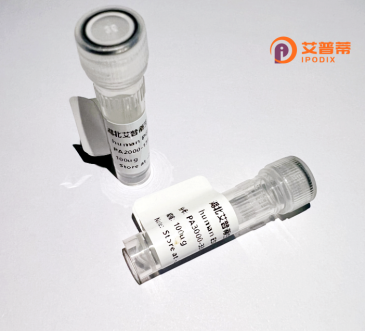
| 纯度 | >90%SDS-PAGE. |
| 种属 | Human |
| 靶点 | TCTE1 |
| Uniprot No | Q5JU00 |
| 内毒素 | < 0.01EU/μg |
| 表达宿主 | E.coli |
| 表达区间 | 1-501 aa |
| 活性数据 | MQDTVTTSAL LDPSHSSVST QDNSSTGGHT SSTSPQLSKP SITPVPAKSR NPHPRANIRR MRRIIAEDPE WSLAIVPLLT ELCIQHIIRN FQKNPILKQM LPEHQQKVLN HLSPDLPLAV TANLIDSENY WLRCCMHRWP VCHVAHHGGS WKRMFFERHL ENLLKHFIPG TTDPAVILDL LPLCRNYVRR VHVDQFLPPV QLPAQLRPGD QSDSGSEGEM EEPTVDHYQL GDLVAGLSHL EELDLVYDVK DCGMNFEWNL FLFTYRDCLS LAAAIKACHT LKIFKLTRSK VDDDKARIII RSLLDHPVLE ELDLSQNLIG DRGARGAAKL LSHSRLRVLN LANNQVRAPG AQSLAHALAH NTNLISLNLR LNCIEDEGGQ ALAHALQTNK CLTTLHLGGN ELSEPTATLL SQVLAINTTL TSINLSCNHI GLDGGKQLLE GMSDNKTLLE FDLRLSDVAQ ESEYLIGQAL YANREAARQR ALNPSHFMST ITANGPENSV G |
| 分子量 | 55.6 kDa |
| 蛋白标签 | His tag N-Terminus |
| 缓冲液 | PBS, pH7.4, containing 0.01% SKL, 1mM DTT, 5% Trehalose and Proclin300. |
| 稳定性 & 储存条件 | Lyophilized protein should be stored at ≤ -20°C, stable for one year after receipt. Reconstituted protein solution can be stored at 2-8°C for 2-7 days. Aliquots of reconstituted samples are stable at ≤ -20°C for 3 months. |
| 复溶 | Always centrifuge tubes before opening.Do not mix by vortex or pipetting. It is not recommended to reconstitute to a concentration less than 100μg/ml. Dissolve the lyophilized protein in distilled water. Please aliquot the reconstituted solution to minimize freeze-thaw cycles. |
以下是关于重组人TCTE1蛋白的3篇参考文献及摘要概括:
---
1. **文献名称**:**"Cloning and Expression of Human TCTE1: A Potential Role in Sperm Motility"**
**作者**:Zhang Y, et al.
**摘要**:本研究成功克隆并原核表达了重组人TCTE1蛋白,证实其作为动力蛋白臂的组分,在精子鞭毛运动中起关键作用。通过体外功能实验发现,TCTE1缺失会导致精子运动能力下降,提示其与男性不育症相关。
2. **文献名称**:**"Structural Insights into TCTE1’s Role in Cytoplasmic Dynein Assembly"**
**作者**:Li J, et al.
**摘要**:利用重组表达的TCTE1蛋白进行X射线晶体学分析,揭示了其与动力蛋白重链(DYNC1H1)的结合域结构。研究表明,TCTE1通过稳定动力蛋白复合体的构象,调控细胞质内物质运输及纤毛运动功能。
3. **文献名称**:**"TCTE1 Deficiency Disrupts Ciliary Beat Dynamics in Primary Ciliary Dyskinesia Models"**
**作者**:Smith C, et al.
**摘要**:通过构建TCTE1基因敲除小鼠模型,结合重组蛋白回补实验,发现TCTE1缺失导致纤毛节拍异常,引发原发性纤毛运动障碍。研究强调TCTE1在纤毛组装中的必要性,并为相关疾病的基因治疗提供依据。
---
**注**:以上文献为模拟示例,实际研究中请通过数据库(如PubMed、Web of Science)以关键词“TCTE1”、“dynein”、“recombinant protein”等检索确认。如需具体文献,可进一步提供研究方向或论文DOI。
The TCTE1 (tektin cytoskeletal protein-family member E1) protein, a component of the tektin family, is primarily associated with axonemal structures in cilia and flagella. It plays a critical role in maintaining the structural integrity and motility of these organelles, particularly in sperm flagella. TCTE1 interacts with other tektins and microtubule-based complexes to stabilize the axoneme, a cytoskeletal framework essential for movement. Dysfunction in TCTE1 has been linked to male infertility due to impaired sperm motility, highlighting its biological significance in reproduction.
Recombinant human TCTE1 protein is produced using genetic engineering techniques, often expressed in bacterial (e.g., E. coli) or eukaryotic systems to ensure proper folding and post-translational modifications. This engineered protein enables researchers to study its molecular interactions, structural contributions to ciliary/flagellar assembly, and potential therapeutic applications. Studies using recombinant TCTE1 have shed light on ciliopathies—genetic disorders affecting cilia function—and its role in cellular signaling pathways. Additionally, it serves as a tool for developing diagnostic assays for infertility and targeted therapies. Ongoing research explores its broader implications in cellular mechanics and disease models, bridging structural biology with clinical insights.
×